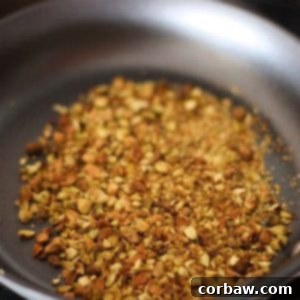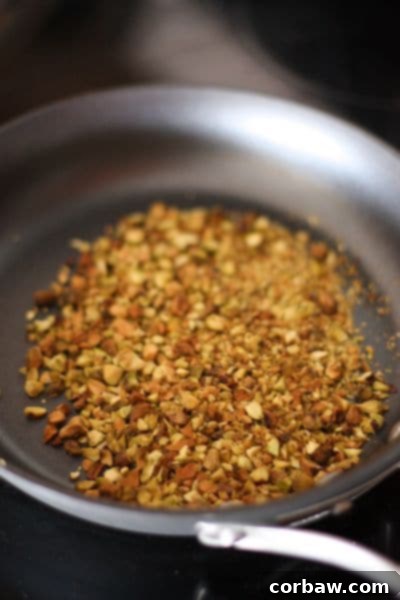Authentic Dukkah Spice Blend Recipe: Elevate Your Meals with This Middle Eastern Delight
Earlier this month, I had the fascinating opportunity to delve into McCormick’s Global Flavor Forecast for 2013. Among the insightful culinary predictions, one trend immediately resonated with me: Empowered Eating. This concept, championed by McCormick, highlights a burgeoning movement where individuals are actively taking charge of their health and nutritional choices. It’s about more than just eating well; it’s about elevating already wholesome foods with vibrant flavors, primarily through the artful use of spices and unique blends. This philosophy deeply aligns with my own approach to cooking and well-being.
The allure of this trend is multifaceted. It speaks to our innate desire for both nourishment and pleasure, demonstrating that healthy eating doesn’t have to be bland or restrictive. Instead, it encourages us to explore a world of flavors that not only tantalize our taste buds but also contribute to our overall health. As someone passionate about wholesome ingredients and delicious food, I couldn’t be more on board with a movement that celebrates both.
One particular recipe featured under the Empowered Eating profile instantly captivated my attention: a traditional Middle Eastern spice blend known as Dukkah. The moment I encountered this recipe, I had an intuitive feeling it would become a staple in my kitchen. I envisioned myself making it, loving it, and incorporating it into countless meals. My instincts, as it turned out, were absolutely correct.
What is Dukkah? Unveiling a Middle Eastern Treasure
For those unfamiliar, like I once was, you might be asking: What exactly is Dukkah? Dukkah is an exquisite and aromatic Middle Eastern spice blend, traditionally originating from Egypt. Its captivating essence comes from a harmonious combination of toasted nuts, seeds, and whole spices, ground together to create a coarse, textural mixture. The beauty of Dukkah lies in its complex flavor profile – nutty, earthy, warm, and subtly spicy – making it incredibly versatile in the kitchen.
This culinary gem can be enjoyed in numerous ways. Perhaps its most iconic presentation involves serving it alongside good quality olive oil and crusty bread for dipping. Imagine dipping a piece of warm pita or crusty baguette first into rich olive oil, then into a bowl of Dukkah, allowing the flavorful blend to cling to the bread. It’s an unforgettable sensory experience that transports you straight to the bustling markets of the Middle East. However, its applications extend far beyond a simple dip. Dukkah truly shines as a spice rub for enhancing the flavor of fish and meats, creating a delightful crust that locks in moisture and adds a burst of flavor. It can also be sprinkled generously over roasted or sautéed vegetables, adding depth and a pleasant crunch. After preparing my first batch of Dukkah earlier this week, I’m wholeheartedly endorsing all these methods and more. I’m particularly excited to try a piece of Dukkah-crusted fish very soon – cooked in a similar fashion to my beloved Almond Crusted Tilapia. What a fantastic and flavorful way to incorporate healthier eating into our daily routines, especially as we look towards new year’s resolutions!
The beauty of Dukkah is also in its wholesome ingredients. Nuts like hazelnuts, pistachios, and almonds provide healthy fats, protein, and fiber, while seeds such as sesame and cumin offer a wealth of micronutrients and antioxidants. Spices like coriander and cumin are renowned for their digestive benefits and unique aromatic compounds. When combined, these ingredients create not just an incredible flavor, but also a nutritional powerhouse, aligning perfectly with the principles of Empowered Eating.
Crafting Your Own Dukkah: A Simple, Rewarding Process
One of the most appealing aspects of Dukkah is how incredibly easy and quick it is to prepare at home. You don’t need exotic ingredients or specialized equipment; just a handful of common spices, sesame seeds, and your favorite nuts. While hazelnuts are traditionally featured in many authentic Dukkah recipes, the blend is wonderfully adaptable. For my first attempt, I opted for pistachios, which lent a beautiful color and distinct flavor. Next time, I’m eager to experiment with almonds, or perhaps a medley of nuts like cashews or pine nuts, to discover new variations.
The preparation process itself is a delightful culinary experience. It begins with toasting the individual components – first the nuts, then the seeds and whole spices – in a dry skillet over medium heat. This crucial step awakens their essential oils, intensifying their flavors and aromas, giving your Dukkah an unparalleled depth. The kitchen fills with a warm, inviting scent as each ingredient releases its fragrant essence. It’s important to toast them separately and keep a close eye to prevent burning, as each ingredient has a slightly different optimal toasting time.
Once perfectly toasted and cooled slightly, the nuts and spices are ready for grinding. Traditionally, this is done using a mortar and pestle, which offers a wonderfully tactile and meditative experience. Grinding in small batches allows for better control over the texture, achieving that characteristic coarse and crumbly consistency without turning the mixture into a paste. If a mortar and pestle isn’t readily available, fear not! A large wooden spoon used against a sturdy bowl can work surprisingly well for crushing. Another excellent alternative is a clean coffee grinder (dedicated solely to spices, of course, to avoid lingering coffee aromas). For a truly rustic approach, you can even place the toasted ingredients in a large, heavy-duty ziplock bag and run a rolling pin over them until you reach the desired texture. The goal is a rustic, slightly uneven grind, where you can still discern the individual components, rather than a fine powder. This texture is key to Dukkah’s appeal, providing a satisfying mouthfeel and visual interest.
Beyond the Dip: Creative Ways to Enjoy Your Homemade Dukkah
While the classic presentation of Dukkah with olive oil and bread is undeniably delicious, its versatility is truly boundless. Initially, I served my freshly made Dukkah to my family as a simple snack with some crusty baguette I had on hand. While perhaps not the most “healthy” way to enjoy it, it was certainly a delightful introduction and proved to be a huge hit!
If you’re hosting guests over the weekend or celebrating for New Year’s, consider impressing them with this unique dipping oil. Pair it with soft pita bread or a rustic baguette, just as I did. It’s an elegant and unexpected appetizer that’s sure to spark conversation. But the culinary adventure doesn’t stop there. Once the holidays pass, Dukkah becomes an invaluable tool for healthy, flavorful eating.
Here are just a few inspiring ways to incorporate Dukkah into your daily cooking:
- Spice Rub for Proteins: Transform lean proteins into gourmet meals. Use Dukkah as a dry rub for chicken breasts, fish fillets (like cod, salmon, or tilapia), lamb chops, or even tofu. The nuts and seeds create a beautiful crust while the spices infuse incredible flavor during baking, grilling, or pan-searing.
- Elevate Vegetables: Sprinkle Dukkah generously over roasted vegetables like broccoli, cauliflower, carrots, or asparagus for an added layer of texture and a burst of Middle Eastern flavor. It also works wonderfully tossed with sautéed greens or steamed vegetables for a quick and healthy side dish.
- Boost Your Breakfast: Sprinkle Dukkah over scrambled or fried eggs for an exotic twist. It’s also fantastic over avocado toast, adding a delightful crunch and savory depth. For a unique sweet and savory combination, try it over plain yogurt with a drizzle of honey.
- Salad Topping: Forget croutons! Dukkah makes an excellent, nutrient-rich topping for green salads, grain bowls, or even a simple cucumber and tomato salad.
- Soups and Stews: A spoonful of Dukkah as a garnish can add a textural element and a complex flavor note to creamy soups or hearty lentil stews.
- Snacks: Sprinkle it over hummus, baba ghanoush, or even popcorn for a sophisticated, savory snack.
The possibilities are truly endless. Once you have a batch of Dukkah stored in your kitchen, you’ll find yourself reaching for it constantly, eager to experiment and add that special touch to your meals. I keep mine in a small mason jar right near my stovetop, alongside my essential salt, pepper, and oils, always ready to lend its magic to whatever I’m cooking.
Print Recipe
Homemade Dukkah Spice Blend
Yield: Makes about 2/3 cup or 10 (1-tablespoon) servings.

Ingredients:
- 1/2 cup coarsely chopped hazelnuts or a combination of nuts, such as hazelnuts, pistachios,
- almonds, cashews, pine nuts or macadamia nuts (I used pistachios for this batch)
- 1 tablespoon McCormick® Gourmet Collection Coriander Seed
- 1 tablespoon McCormick® Sesame Seed
- 1 1/2 teaspoons McCormick® Cumin Seed
- 1/4 teaspoon McCormick® Ground Black Pepper
- 1/2 teaspoon salt (or to taste)
Directions:
- Heat a medium-sized skillet over medium heat. Add the coarsely chopped nuts to the dry skillet. Cook and stir continuously for 2 to 3 minutes, or until they become fragrant and lightly toasted. It’s crucial to watch them carefully to prevent burning. Immediately pour the toasted nuts out of the hot pan onto a plate or cutting board to stop the toasting process. Set them aside to cool. Next, in the same skillet, add the coriander seeds, sesame seeds, and cumin seeds. Toast them over medium heat for approximately 2 minutes, stirring frequently, until they become fragrant and lightly golden. Again, immediately remove them from the hot pan to prevent over-toasting.
- Once cooled, place about half of the toasted nuts into a clean coffee grinder (reserved for spices) or a mortar and pestle. Process or grind until they are finely ground and crumbly, ensuring you avoid over-processing which could turn them into a paste. Transfer the ground nuts to a small mixing bowl. Repeat this process with the remaining nuts, then with the toasted seed mixture, grinding them to a similar coarse, crumbly consistency. Add the ground black pepper and salt to the combined nut and seed mixture. Mix thoroughly until all the ingredients are well blended. Store your freshly made Dukkah in an airtight container in a cool, dry place. It will retain its vibrant flavor and aroma for up to 1 month.
Dukkah, an exquisite and aromatic Middle Eastern spice blend, is most famously enjoyed sprinkled over olive oil-dipped pita bread or crusty baguette. Its versatility extends far beyond dipping; experiment by using Dukkah to flavor roasted vegetables, mix into pasta dishes, sprinkle over rice, or as a delectable spice rub for various seafood and meats to add a truly unique culinary dimension.
Follow AggiesKitchen on Instagram and show us what delicious recipes you are making from the blog! Don’t forget to use the hashtag #aggieskitchen – I’d absolutely love to see what culinary creations you’re cooking up!
(Disclosure: I have proudly partnered with McCormick & Company for this post. Please be assured that all thoughts and opinions expressed on this blog are, as always, entirely my own and reflect my genuine experience and perspective.)
